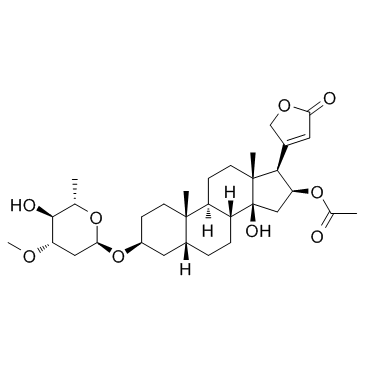465-16-7
| Name | oleandrin |
|---|---|
| Synonyms |
(3β,5β,16β)-16-(acetyloxy)-3-[(2,6-dideoxy-3-O-methyl-α-L-arabino-hexopyranosyl)oxy]-14-hydroxycard-20(22)-enolide
Corrigen OLEANDRIN Neriolin (3β,5β,16β)-16-Acetoxy-3-[(2,6-dideoxy-3-O-methyl-α-L-arabino-hexopyranosyl)oxy]-14-hydroxycard-20(22)-enolide Cholesteryl-methyl-ether Cholesterin-methylether (3b,5b,16b)-16-(Acetyloxy)-3-[(2,6-dideoxy-3-O-methyl-a-L-arabino-hexopyranosyl)oxy]-14-hydroxycard-20(22)-enolide Folinerin Cholesterin-monomethylether EINECS 207-361-5 |
| Description | Oleandrin inhibits the Na+, K+-ATPase activity with an IC50 of 620 nM. |
|---|---|
| Related Catalog | |
| Target |
IC50: 620 nM (Na+, K+-ATPase)[1]. |
| In Vitro | Study of Na,K-ATPase inhibition shows an IC50 (nM) of 620 for Oleandrin. The inhibition of Na,K-ATPase by Oleandrin confirms that it likely exert its toxic effect through inhibition of sodium pump activity[1]. When treated with a series of concentrations of Oleandrin (0.2-25 nM), the undifferentiated CaCO-2 cells are sensitive as evidenced by an IC50 of 8.25 nM. In contrast, a maximum growth inhibition of only 20% is reached in differentiated CaCO-2 cells even though they are treated with Oleandrin concentrations as high as 25 nM[2]. |
| In Vivo | The effect of Oleandrin is investigated on glioma growth in vivo. To this aim, SCID or C57BL/6 mice are transplanted, respectively, with human U87MG (5×104), U251, GBM19 (5×105), or murine (syngeneic) GL261 (7.5×104) cells into the right striatum and, after 10 d, treated daily with intraperitoneal Oleandrin for an additional 7 d. Oleandrin significantly reduces tumor sizes in human and murine glioma cell models in vivo in a dose-dependent way. High concentrations of Oleandrin (3 mg/kg) are fatal in both models, as expected from the known lethal dose for rodents. Doses of Oleandrin below the lethal dose (0.3 mg/kg) significantly increase the survival time from 32.6±1.4 d to 53.8±9.6 d in mice injected with U87MG cells (n=5-11; p<0.01, log-rank test) and from 23.37±1.2 d to 34.38±3.3 d (n=5-11; p<0.01, log rank test) in mice injected with GL261 cells[3]. |
| Cell Assay | Undifferentiated wild-type and well-differentiated CaCO-2 cells are treated with a range of concentrations of Oleandrin (0.2-25 nM). After 48 h, cells are labeled with BrdU and relative cell proliferation is determined with a BrdU Cell Proliferation Kit[2]. |
| Animal Admin | Mice[3] After tumor cell injection, SCID or C57BL/6 mice are monitored daily. The end point is determined by lack of physical activity or death. The mean survival time is calculated using the Kaplan-Meier method and statistical analysis is performed using a log-rank test. For cotreatment with Temozolomide (TMZ), 10 d after tumor injection, mice are treated with Oleandrin (0.03, 0.3, or 3 mg/kg/daily, i.p.), TMZ (50 mg/kg, i.p., every 2 d for a total of 4 times with a stop of 2 weeks) or both. The dosing scheme is chosen starting from these data to be reasonably sure that a constant concentration of drug is maintained along the experiment. Animals used in Kaplan-Meier survival studies receive up to four TMZ cycles. |
| References |
| Density | 1.26 |
|---|---|
| Boiling Point | 693.7±55.0 °C at 760 mmHg |
| Melting Point | 250ºC |
| Molecular Formula | C32H48O9 |
| Molecular Weight | 576.718 |
| Flash Point | 217.2±25.0 °C |
| Exact Mass | 576.329834 |
| PSA | 120.75000 |
| LogP | 2.30 |
| Vapour Pressure | 0.0±4.9 mmHg at 25°C |
| Index of Refraction | 1.567 |
| Symbol |


GHS06, GHS08 |
|---|---|
| Signal Word | Danger |
| Hazard Statements | H300 + H330-H373 |
| Precautionary Statements | P260-P264-P284-P301 + P310-P310 |
| Hazard Codes | T |
| Risk Phrases | 23/24/25 |
| Safety Phrases | 22-36/37/39-45 |
| RIDADR | UN 2811 |
| RTECS | FH4585000 |
